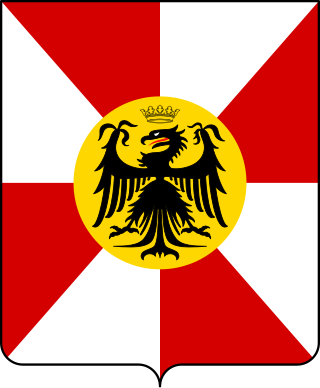Battle
On 20 February 1339, with deep snow on the ground, [2] Lodrisio's army attacked one of the two corps in which the Milanese army had divided, and which was camping near what is now the Canale Villoresi, near Parabiago. The Milanese were routed and retired to Milan with Lodrisio's troops in pursuit. Here the two main corps met and the Milanese were again defeated with Luchino captured. However, the Milanese militia did not retreat completely and offered a confused but effective resistance. In the meantime da Panigo's knights joined with some fugitives at Rho and moved to Parabiago where they defeated the 400 men-at-arms left by Lodrisio and freed Luchino.
In the meantime, news of the initial defeat reached Azzone, who ordered his men to move in and prepared to besiege Lodrisio's army. When the German mercenaries were attacked by da Panigo's men they were completely routed, and Lodrisio captured in turn.
Total casualties amounted to some 6,500–7,000.
Lodrisio Visconti was imprisoned in an iron cage in San Colombano al Lambro until 1349, when Azzone and Luchino died and Giovanni Visconti freed him.

Galeazzo II Visconti was a member of the Visconti dynasty and a ruler of Milan, Italy. His most notable military campaigns were against Pope Gregory XI, around 1367. These battles fought between the papacy and the Visconti family ultimately ended in a peace treaty. Politically active, he expanded the power of his family, where the Visconti first became hereditary rulers of Milan starting in 1349. He is remembered in conjunction with his patronage of intellectuals and writers, from his sponsorship of Petrarch to the founding of the University of Pavia in 1361. Galeazzo II Visconti, and his brother Bernabò, are credited with the institution of the Quaresima Torture Protocol, a vicious means of torture.

Condottieri were Italian captains in command of mercenary companies during the Middle Ages and of multinational armies during the early modern period. They notably served popes and other European monarchs during the Italian Wars of the Renaissance and the European Wars of Religion. Notable condottieri include Prospero Colonna, Giovanni dalle Bande Nere, Cesare Borgia, the Marquis of Pescara, Andrea Doria, and the Duke of Parma.

The Visconti of Milan are a noble Italian family. They rose to power in Milan during the Middle Ages where they ruled from 1277 to 1447, initially as Lords then as Dukes, and several collateral branches still exist. The effective founder of the Visconti Lordship of Milan was the Archbishop Ottone, who wrested control of the city from the rival Della Torre family in 1277.

The Duchy of Milan was a state in Northern Italy, created in 1395 by Gian Galeazzo Visconti, then the lord of Milan, and a member of the important Visconti family, which had been ruling the city since 1277.
The War of the Eight Saints (1375–1378) was a war between Pope Gregory XI and a coalition of Italian city-states led by Florence that contributed to the end of the Avignon Papacy.

Parabiago is a town located in the north-western part of the Metropolitan City of Milan, Lombardy, northern Italy.

Giovanni Visconti (1290–1354) was an Italian Roman Catholic cardinal, who was co-ruler in Milan and lord of other Italian cities. He also was a military leader who fought against Florence, and used force to capture and hold other cities.
Lodrisio Visconti was an Italian condottiero.

Azzone Visconti was lord of Milan from 1329 until his death. After the death of his uncle, Marco Visconti, he was threatened with excommunication and had to submit to Pope John XXII. Azzone reconstituted his family's land holdings, taking numerous cities. He died in 1339.

Luchino Visconti (also spelled Lucchino, 1287 or 1292 – January 24, 1349) was lord of Milan from 1339 to 1349. He was also a condottiero, and lord of Pavia.
The Great Company was a group of mercenaries, chiefly of German origin but operating in the Italian peninsula, who flourished in the mid-14th century. At its height, the company numbered approximately 10,000-12,000 men, chiefly armored cavalry. The Great Company's power set the pattern for later condottieri who came to dominate Renaissance Italian warfare.
The Compagnia di San Giorgio was the name of several companies of mercenaries in Italy during the 14th century.

Pinalla Aliprandi was a Milanese commander of the 14th century.

Martino Aliprandi was an Italian lawyer and mayor of the 14th century.

Ludovico I Gonzaga was an Italian lord, the founder of the Gonzaga family who was the first capitano del popolo of Mantua and imperial vicar.
The La Compagnia della Stella was the name of two separate companies of mercenary soldiers which operated in northern Italy at different times in the 14th century.
Konrad Wirtinger von Landau, known in Italy as Conte Lando, was a German military adventurer and condottiero who was active in north and central Italy.

Galeas per montes is the name given to a feat of military engineering made between December 1438 and April 1439 by the Republic of Venice, when several Venetian ships, including galleys and frigates were transported from the Adriatic Sea to Lake Garda. The operation required towing the ships upstream on the river Adige until Rovereto, then transporting the fleet by land to Torbole, on the Northern shores of the lake. The second leg of the journey was the most remarkable achievement, requiring a land journey 20 km through the Loppio Lake and the narrow Passo San Giovanni.

The Visconti Castle of Crenna is a castle of mediaeval origin located in Crenna, frazione of Gallarate, Lombardy, Northern Italy. It is linked to the fame of Lodrisio Visconti, who raised against and then reconciled with the members of the family of his cousin Matteo Visconti, Lord of Milan. In the 14th century, the castle underwent expansion and destruction according to the alternative fortunes of Lodrisio.
Rinaldo Giver, known as Malerba, died 1345, was a German or Swiss condottiero.













